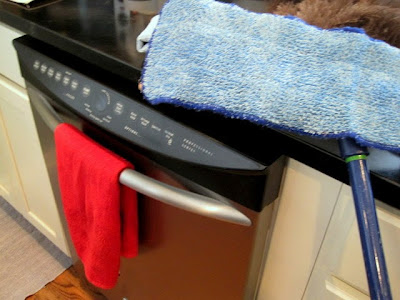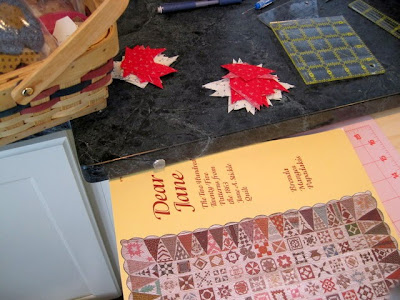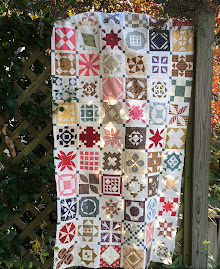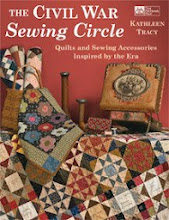Even though I love scrappy quilts the best, with their wide variety of prints, lately I've become fascinated with two-color quilts. Hard to believe, huh? I was recently drawn to one in particular I saw in a magazine that had a white background with blue baskets. We usually think of two-color quilts as being made from white fabric combined with another color--red and white or blue and white being the most popular. In antique quilts, most often the color was a solid instead of a print or looked like a solid from a distance.
My friend Julia is lucky enough to have a couple of antique quilts in her family that are two-color quilts and I wanted to show you photos. Don't you love them? Especially the redwork.This quilt is dated 1914 and labelled "From Mother." Quite a lot of work went into that embroidery.
If you look closely at the quilting on this one you can see that it's quilted with an orange peel design (on the left side). My next book will have a little quilt that I quilted with an orange peel motif in the blocks.
I made a little blue and white quilt that appeared in my first book, American Doll Quilts, using several different indigo prints and a variety of shirtings prints. I get more comments on this little quilt than you can imagine. I used blue thread and a decorative stitch on my sewing machine in the border as a fancy touch. In the 19th century, sometimes these blue and white quilts were made as heirlooms and for a special occasion--a birth, wedding or anniversary.
There are a few reasons blue and white quilts were popular in the past. Indigo was a colorfast dye and didn't fade when washed. Plus, indigo was widely available, making it likely that more women had access to this color of fabric. I like to think that the women who quilted around then also just had good taste because blue is such a pretty color anyway. Some historians also think that another reason blue and white quilts were so popular around the turn of the last century or slightly before was because those were the colors of the Women's Christian Temperance Union, which was an extremely popular and important reform movement for women at the time. Many Drunkard's Path quilts from the time period were done in blue and white. I've included a scrappy little blue and white quilt in my next book too, yay! You'll get to see it soon!
Two-color quilts were also made with 2 colors long ago, not just white and one other color. Pink and indigo blue seems to have been a favorite combination because I've seen quite a few of these.
Not sure if these count because the blue print below contains a little white, but I've actually made a few of this two-color kind of quilt myself:
That's the great thing about making small quilts--you can try just about any style you like without expending a lot of energy, time or fabric. Experiment and who knows, maybe you'll find out you like a certain block or style so much you'll go on to make a bigger version, a real quilt. I'm determined to make an Irish chain quilt using blue prints and shirtings someday. Won't that be fun!



































































